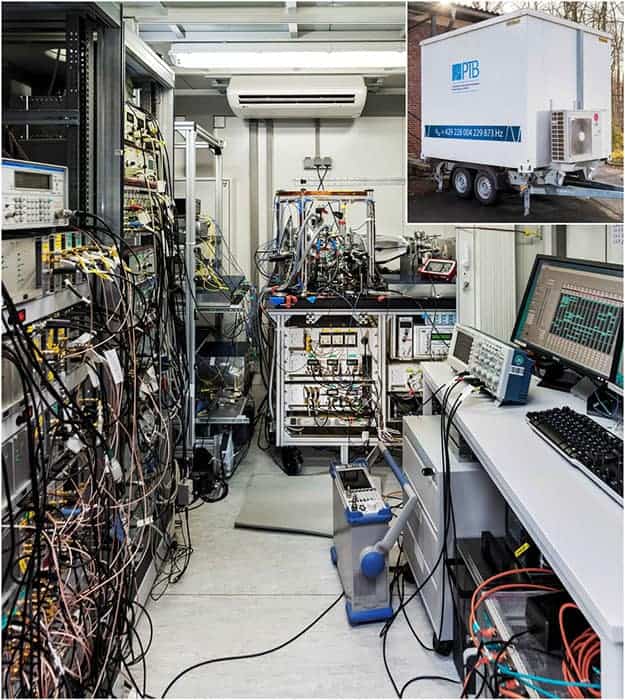
Two independent groups of physicists in Germany and China have built portable optical clocks that are more accurate than the best caesium devices. They say that their instruments could be used to compare the timekeeping of different optical clocks distributed across the globe, and so take us closer to an overhaul of the SI definition of the second. They also reckon their compact clocks could be used by geodesists to determine the height difference between two widely spaced points on the Earth’s surface.
All atomic clocks rely on counting the oscillations of an electromagnetic wave with a frequency that is locked to that of a known atomic transition. Traditional atomic clocks use a microwave transition in caesium-133 to fix the output of a crystal oscillator, whereas optical clocks use much higher optical frequencies generated when a monochromatic laser beam interacts with various species of trapped ions or with clouds of cold atoms. These clocks now have accuracies and stabilities that are nearly two orders of magnitude higher than those of the best caesium devices – at levels of a few parts in 1018 rather than 1 part in 1016.
These improvements have led to calls for a change in the definition of the second within the SI system of units, from one based on the caesium-133 transition to another based on an optical standard. However, such a move requires a way of comparing the ticking rate of optical clocks located in different laboratories around the world – which is harder to do than a comparison of microwave frequencies.
Clock in a caravan
Now, Christian Lisdat and colleagues at the Physikalisch-Technische Bundesanstalt (PTB) in Braunschweig have shown how this could be done by making a compact optical clock that can be transported in an air-conditioned trailer. Their clock consists of several thousand neutral strontium-87 atoms that are held in place, cooled and excited by lasers. Lisdat says that among the main challenges involved in building the portable system were shrinking the laser systems for cooling and preparation of the atoms. Also difficult was to build a vacuum system for holding the atoms that is compact but at the same time doesn’t cause the lasers to misalign when it is transported.
Another major hurdle the group had to overcome, says Lisdat, was holding in place the optical cavity used to stabilize the frequency of the monochromatic laser that excites the strontium atoms. The kind of soft pads used to support the cavity in a laboratory, he explains, would not survive the clock’s journey by road. The solution, developed by group member Uwe Sterr, was to mount the cavity inside a 3D arrangement of wires that squeeze the cavity to keep its length set to a very precise value. “If you don’t make these corrections, even a tiny vibration will degrade the quality of the laser,” says Sterr.
As Lisdat and colleagues used their clock to carry out two measurement campaigns on the road, and by comparing its performance against that of a stationary optical clock, they showed it was accurate to 7.4 parts in 1017. In particular, they found it was an order of magnitude more accurate and two orders of magnitude more stable than the best portable caesium clock. They are now working to improve the clock’s accuracy by better understanding the behaviour of the lasers used to trap the strontium atoms, and describe their current clock in a paper in Physical Review Letters.
Single ion
Meanwhile in China, a team led by Xueren Huang of the Wuhan Institute of Physics and Mathematics has obtained a similar uncertainty (7.7 parts in 1017) from its own transportable optical clock. The system is based on a transition of a single ion of calcium-40 and is described in a preprint on arXiv.
According to Rachel Godun of the National Physical Laboratory in the UK, the Chinese system has the advantage of simplicity, which, she says, makes it smaller – at just half a cubic metre (minus the electronics) – and cheaper. Writing in an article in Physics that accompanies the Physical Review Letters paper, she says that the PTB set-up benefits from having more atoms and therefore a better signal-to-noise ratio. This, she explains, means it can reach a given statistical uncertainty much more quickly – allowing it to make measurements in minutes rather than days.
Comparisons between atomic clocks in different parts of the world are often carried out using satellites, but noise limits the sensitivity of such comparisons. Optical-fibre networks offer a better method of comparison, but these need special amplifiers at intervals of about 100 km to compensate for lost power. While this can be done on land, creating a similar link between continents would be far costlier. It is here, according to Godun, that the new transportable optical clocks would be very useful. They “could travel between laboratory clocks located anywhere in the world”, she says, so enabling “significant progress towards a redefinition of the SI second”.
Height differences
Godun points out that these portable clocks could also have other applications, including in geodesy. General relativity tells us that time runs more quickly further away from a massive object, which means that clocks on Earth will tick at very slightly different rates, depending on how high up they are. Optical clocks with accuracies of one part in 1017 could resolve height differences of a mere 10 cm, she says, so making them competitive when it comes to comparing the heights of sites that are separated by hundreds of kilometres – a time-consuming task when using the traditional technique of spirit levelling.
Godun adds that optical clocks transported to remote locations could also be used for “long-term environmental monitoring by measuring height changes in ice sheets and ocean levels”.



